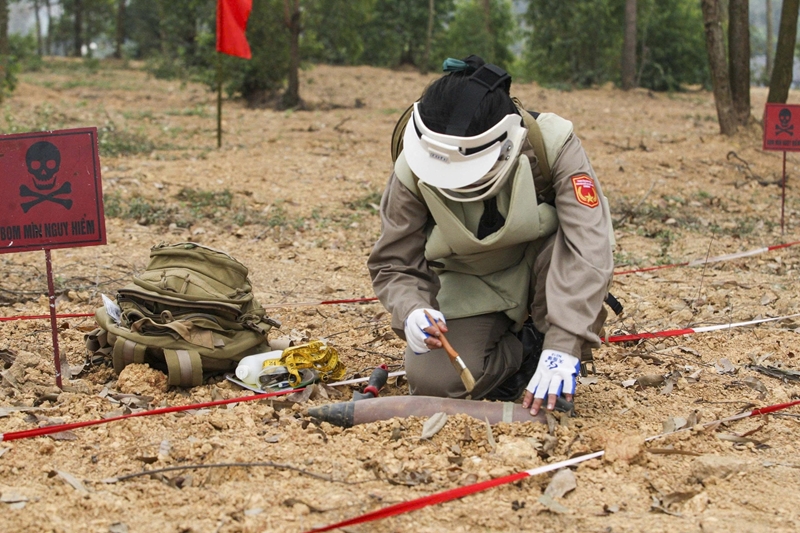Goodwill even before war ended
Vietnam began the search for missing U.S. servicemen shortly after the signing of the Paris Agreement in 1973. This activity was elevated to a higher level in 1988 with the establishment of joint Vietnam - U.S. search teams. Thanks to the joint efforts of both sides, 170 search missions have been conducted to date, contributing to the repatriation of hundreds of remains of missing U.S. soldiers. This joint activity helped build trust, paving the way for the normalization and enhancement of bilateral diplomatic relations.
Once former adversaries, Vietnam and the U.S. have now normalized relations and upgraded them to a comprehensive strategic partnership, opening up new opportunities for cooperation in various areas, particularly war legacy relief.
The joint activity does not only benefit the U.S. side. In recent years, the U.S. has provided Vietnam with many files on fallen or missing Vietnamese soldiers, along with various war keepsakes. This is an area where the Vietnamese Ministry of National Defense wishes to continue receiving U.S. support, especially as Vietnam still has around 180,000 martyrs yet to be found.
    |
 |
|
Mine clearance training for officers of the Vietnam National Mine Action Center at Hanoi-based Trung Ha Training Ground, which was funded, built, and handed over to Vietnam by the U.S. in October, 2024 |
In July this year, the U.S. handed over equipment, materials, chemicals, and processes to support DNA testing in order to improve Vietnam’s capacity in identifying the remains of martyrs. The initial results of this project have been highly encouraging with the success rate of DNA extraction from bone samples increasing from 22% to 70%, marking a significant technological advancement.
Notably, the application of gene sequencing and SNP marker analysis has enabled matching with relatives up to the fourth or fifth generation, something previously unattainable. This is the first time experts have demonstrated the feasibility of applying advanced technology to identify the remains of Vietnamese soldiers.
Expanding cooperation in settling war legacy
Reviving the “dead lands” polluted by bombs, mines, and dioxin; supporting the victims of deadly war legacies; and bringing back peace to people’s lives have been persistent efforts by the Ministry of National Defense and relevant agencies. The achievements of these efforts owe much to defense diplomacy over the years.
According to published surveys, it is estimated that around 800,000 tons of unexploded ordnance (UXO) remain in Vietnam after the war. As of 2023, despite decades of mine clearance efforts, approximately 5.6 million hectares, equivalent to 17.71% of the country’s total area, are still contaminated. This figure highlights the enormous time and resources still needed to completely clear these hazards and ensure safety for the population.
Currently, Vietnam has over 7 million people with disabilities, tens of thousands of whom are victims of bombs, mines, and dioxin. Since 1975, post-war UXO has killed more than 40,000 people and injured 60,000 others, mostly breadwinners and children. In several central provinces, more than 22,800 people have been victims of UXO accidents during daily activities and production, among them 10,540 were killed and 12,260 injured. These figures vividly illustrate the severe and lasting consequences of war.
Addressing these consequences requires tremendous international support. Defense diplomacy activities have helped the world better understand the war’s aftermath in Vietnam and join hands in overcoming them.
Over the years, dozens of projects with a total investment of hundreds of millions of USD have been implemented for UXO clearance, dioxin remediation, and victim assistance. Notably, former Quang Tri province, one of the most heavily contaminated areas, is expected to declare itself free from UXO contamination by 2025, a truly remarkable milestone given the immense time and resources needed for such work.
In addition, the successful completion of dioxin cleanup projects at Da Nang Airport in 2018 and A So Airport of Hue city in 2023, as well as the ongoing dioxin remediation at Bien Hoa Airport in Dong Nai province not only helps reclaim “dead lands” for socio-economic development but also stands as vivid evidence of the achievements brought about by international cooperation and defense diplomacy.
(to be continued)
By Ngoc Hung - Anh Vu
Translated by Mai Huong